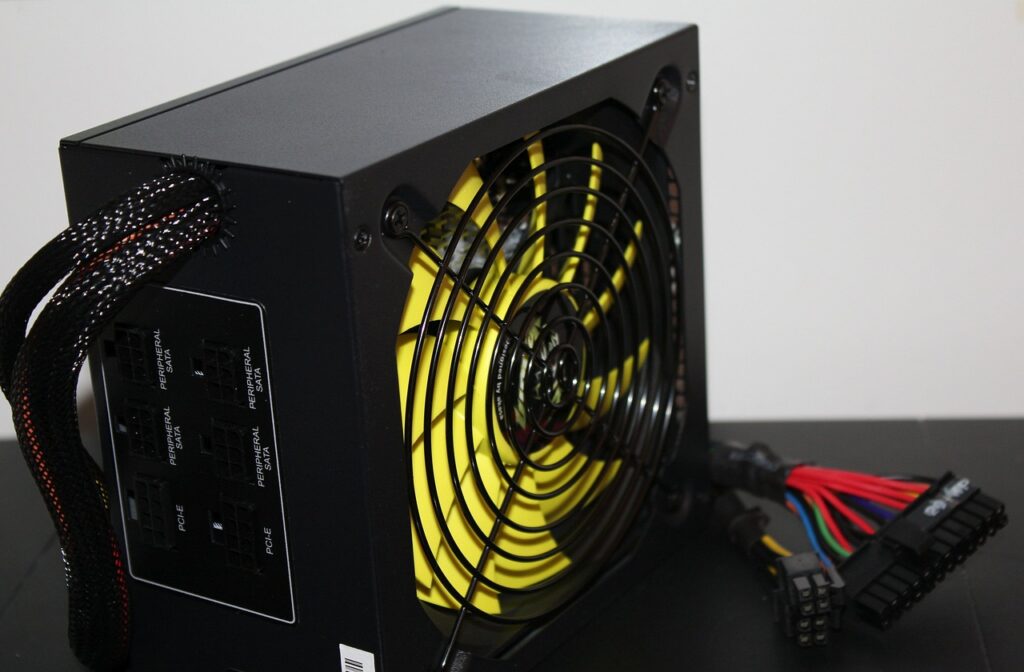The hardware components used and the load placed on the system while gaming can impact a gaming PC’s power consumption. However, depending on the hardware used and how much they are used during gameplay, a gaming PC can consume 400 to 1000 watts of power on average.
More specifically, a gaming PC’s power consumption is primarily caused by components like the CPU, graphics card, and power supply unit (PSU). Gaming PCs with multiple graphics cards and high-performance components can draw up to 1000 watts. Whereas gaming PCs from the medium to low tier components can draw between 400 and 500 watts.
It is essential to know that overclocking, cooling systems, and other peripherals connected to the system can all impact power consumption.
Table of Contents
Why do gaming computers require more power to operate?
Gaming PCs are designed to handle more demanding and resource-intensive tasks like playing graphically intensive games, rendering videos, or running other multimedia applications. As a result, gaming PCs typically require more energy to operate than regular PCs or laptops.
Gaming PCs require fans and additional cooling systems like water cooling to control the heat produced by various components like powerful processors and high-end graphics cards. Additionally, the number of peripherals, such as speakers, keyboards, mice, and monitors, in gaming PCs also contributes to the system’s overall power consumption.
Average Energy Consumption of a Gaming PC
The average energy usage of gaming computers is broken down further by type. Due to the variations in their components, the energy consumption statistics of the three PCs—high-end, mid-range, and budget—will differ.
During normal operation, a mid-range gaming PC with a single graphics card and a mid-tier CPU may consume approximately 400-500 watts. Power consumption may exceed 1000 watts for a high-end gaming PC with custom cooling systems, multiple graphics cards, and a powerful CPU.
Power Utilization of individual PC Components
The power consumption of each PC part is listed below. If you want to reduce the amount of power used by your PC, this will make it easier for you to determine where to work.
CPU
In the more medium to low-tier gaming computers, the CPU consumes the most energy to operate all computer components. The computer chip model is the deciding factor when it comes to power utilization. Power consumption for a low-end CPU can reach 95 Watts.
A mid-range computer processor, nonetheless, can utilize something like 125 Watts of force. A high-end computer’s CPU can draw up to 150 Watts of power when used for gaming, video editing, or graphic design.
GPU
GPUs generally consume less power than CPUs. The GPU’s power consumption is again determined by its model. Most low-end GPUs for budget PCs consume around 120 Watts of power.
Likewise, a mid-range GPU on your PC could consume up to 200 Watts of force. A high-end GPU, like the NVIDIA RTX 4090, can also draw up to 500 Watts of power. Again, these numbers may fluctuate based on how the GPU is utilized, you might see higher numbers if you push your GPU to its limit.
Perhaps you’ll be thinking right now to move towards your older GPU rather than growing out a huge electricity bill. This may come at the price of performance and we recommend against using an old GPU when your current GPU is doing just fine. But if you really want to know what you can do with that old GPU getting dusty in your cupboard, you may read this helpful post.
RAM
The power consumed by the RAM is directly proportional to its size. A 4GB RAM stick uses a nonexistent power of 1.5 watts. However, if you reach 16 GB, your RAM may consume up to 6 Watts of power. If you increase the capacity to 32 GB, the power consumption will increase to 12 Watts.
STORAGE
In this section, we will discuss both solid-state drives (SSDs) and hard disc drives (HDDs). Your 2.5-inch HDD will require power consumption of up to 3 Watts. A 3.5″ HDD has a most extreme power utilization of 15 Watts. SSDs, on the other hand, are said to be more popular than HDDs due to their lower power consumption. Power requirements for an SSD range from 3.5 to 8.5 Watts.
COOLING FANS
The fans in the computer case use power as well. The power consumption of PC fans is influenced by their size and RPM. At the very least, a PC fan may consume as little as 0.6 Watts of power. However, as the fan dimensions and RPM increase, the power requirement may rise to 6 Watts.
MONITORS
The power consumption of the monitor may also differ between models. Power consumption for budget monitors can be as low as 25 Watts. On the other hand, a mid-range monitor may require as much as 50 Watts of power. Finally, a high-end display (4K or more) might require power consumption of up to 70 Watts.
PSU AND MOTHERBOARD
Even though these parts are very different from one another, how much power they need is completely determined by how much power other parts need. This is because these two components are in charge of providing power to the other components.
However, the motherboard actually can handle 150 Watts of power. Between 200 and 1800 Watts can be used at once by a PSU. Yet again the model of the PSU is exclusively liable for this power utilization measurement.
Which component of the gaming computer draws more power?
The amount of power consumption of a gaming PC depends on the hardware components used and how much they are utilized during gameplay. However, some parts of a gaming PC typically consume more power than others.
A gaming PC’s graphics processing unit (GPU) typically consumes the most power. This is because rendering and displaying high-resolution graphics in real time requires a lot of power for a high-performance GPU. Another reason why GPUs are so power-hungry is because of the numerous processing cores used in them.
In a gaming PC, the CPU is the second most power-hungry component. CPUs of today can use a lot of power, especially when overclocked or working with a lot of loads. However, the CPU’s power consumption is typically lower than the GPU’s.
Other parts of a gaming PC that are somewhat ignored in the calculation of power consumption include the power supply unit (PSU), cooling framework, and extra peripherals like screens and gaming peripherals. To supply the GPU and CPU with sufficient power, a high-performance PSU is required. Additionally, high-end fans and liquid coolers use additional power to control the system’s heat.
Total Wattage of a Gaming Computer
A typical entry-level or budget PC should consume approximately 400 watts, a mid-range PC approximately 550 watts, and a high-end gaming PC with top spec requirements of approximately 1,000 watts
How Can You Measure Your Computer’s Electricity Consumption
Using a power meter or calculating the wattage based on the system’s components to determine your computer’s electricity consumption are two methods
Using a power meter or an energy usage monitor is one of the simplest methods for determining how much electricity is consumed by your computer. These devices usually connect to the PC’s main power cable and plug into a power outlet for seamless measurement of power consumption by your gaming rig.
Calculating the wattage of your PC’s components allows you to estimate its electricity consumption in the absence of a power meter or energy usage monitor. The wattage rating for each component can be found either on the labeling of the PC part itself or in the specifications provided by the manufacturer. As we did earlier, the estimated total power consumption of your computer can be calculated by adding the wattages of each component.
Utilizing an online power supply calculator (famously from Newegg and Cooler Master) is yet another method for estimating the power consumption of your PC. These number crunchers can give a very good estimate of your PC’s power utilization given that you know the power of the parts utilized in your gaming rig.
How to Reduce PC Power Consumption
Now that we have gone over the exact numbers of PC power usage, many gamers need to reduce that number to an optimum level where gaming is also possible, and the bill is also bearable. We suggest you the following good old techniques to curb your Gaming PCs power consumption issues.
Eliminate dust
Dust blocks the flow of heat and electricity because it is an insulator. When dust builds up in your cooling system, it needs to work harder to lower the interior temperature. As a result, the hardware will continue to operate more hotly and consume more power.
Due to the excessive use, your electricity costs could skyrocket. You should clean your system every few months. If your case permits it, place dust filters before the intake fans to prevent dust from entering the system in the first place.
Do Sufficient Overclocking
Overclocking is a fun hobby as long as you get the most out of your computer. It still has some drawbacks, one of which is that it uses more power, despite the benefits. Overclocking again puts too much stress on your components. When they operate beyond their standard capabilities, your components consume more power.
Avoid Inadequate cooling system
The components of a high-end PC may generate more heat than those of a low-cost or office PC. If you only use fans, they may not be able to adequately dissipate the heat that is produced. As was mentioned earlier, your fans might be operating more frequently than they should, which will use more power.
Replace Older components
Due to following two factors, older parts typically use more energy:
- Due to wear and tear caused by frequent use, the circuits are less reliable.
- They are built with old technology that doesn’t use the most recent developments in power-efficient operation.
Changes as simple as these could help cut down on energy waste:
Set up an SSD: An SSD is significantly faster and uses at least 25% less energy than a traditional hard disk.
Switch out your old monitor because LED models use much less power than LCD and CRT models.
PSU: Since they are unable to deliver the watts that their nominal ratings imply, upgrade to a more powerful PSU. The efficiency rating of your power supply unit ought to be at least 80.
Adjust the Levels of Monitor Brightness.
This is a decent idea for power protection. While using your PC, it is preferable to set the brightness a little lower than the maximum setting. You will put a lot of strain on your eyes if you lower it so low that you can’t see the screen.
Conclusion
Perhaps you are aware of the amount of power required by a typical gaming computer. Again, it is entirely dependent on the components and your use. Reading this article might have shown you how much electricity your computer uses each month.
By utilizing each of the provided methods to determine their power consumption, you can keep an eye on your components and identify any unusual changes sooner. Before seeing an expert or changing your parts, endeavor the previously mentioned guidance to help yourself with the odd power use varieties.

